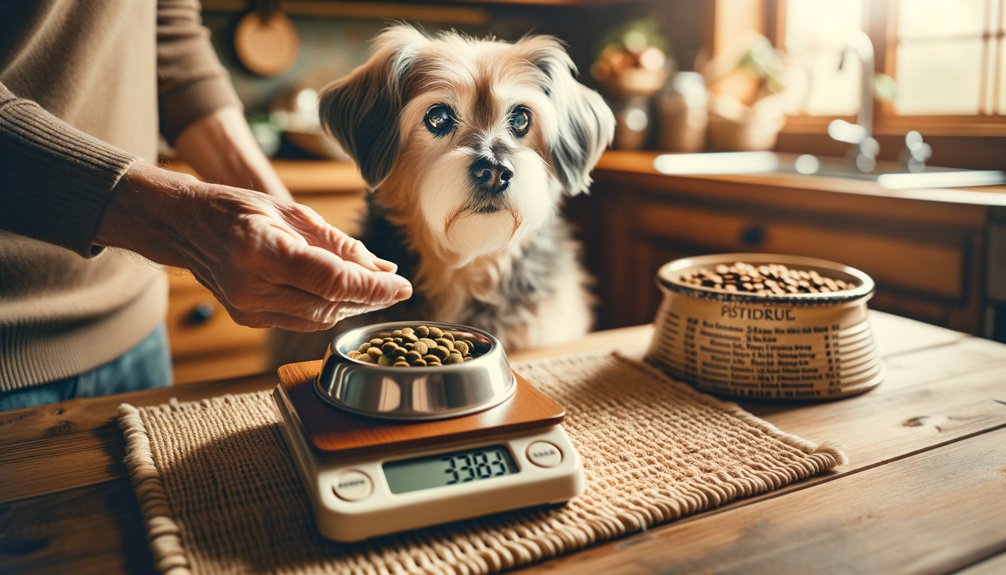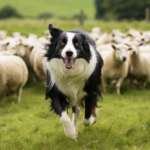The Best Fluffy Pancakes recipe you will fall in love with. Full of tips and tricks to help you make the best pancakes.

Balanced, calorie-smart meals with high-quality protein, added omega-3s, and palatable moisture can help your senior small breed thrive—discover how to adapt feeding now. As your little companion enters their golden years, you’ll notice some graceful slowdowns that call for smarter feeding choices. You’ll need calorie-conscious, protein-rich meals with defined amino acids, added omega-3s, and higher nutrient density to preserve lean mass and cognitive function. Small, frequent portions and moisture-rich textures help appetite and hydration while accommodating dental sensitivity. Keep monitoring weight and stool, because timely adjustments and vet input make the difference between stable aging and preventable decline.
Key Takeaways
- Provide a nutrient-dense, senior-formulated diet high in quality animal protein to preserve lean muscle without excess calories.
- Feed three to four measured small meals daily to match limited gastric capacity and stabilize blood glucose.
- Include moist or wet components and encourage drinking to support hydration and digestive health.
- Monitor weight, body condition, appetite, gait, and dental status weekly and log changes for your veterinarian.
- Adjust protein, phosphorus, fat, and omega-3 levels as guided
Understanding Nutritional Needs of Senior Small Breeds

How do the nutritional needs of senior small-breed pets differ from those of younger animals? You’ll need to recognize metabolic shifts that accompany aging: reduced caloric requirement, altered protein turnover, and higher susceptibility to age related liver dysfunction. Clinical data show seniors often require nutrient-dense diets to maintain lean mass while avoiding excess calories; you’ll balance energy restriction with adequate high-quality protein to preserve muscle and support hepatic function. Monitor for gait changes as an early indicator of muscle loss, osteoarthritis, or neuromuscular decline that nutrition can influence. You’ll also watch for changes in appetite, hydration, and digestive efficiency; smaller breeds can decompensate faster, so incremental adjustments are safer. Work collaboratively with your veterinarian to track body condition score, serum biochemistry (including liver panels), and mobility assessments. You’ll feel supported when care plans reflect shared decisions, measurable targets, and regular reassessment to optimize healthspan without overmedicalizing normal aging.
Choosing the Right Food: Key Ingredients and Formulas
Now that you’re monitoring metabolic shifts, body condition, and liver panels, selecting the right diet becomes a targeted intervention rather than guesswork. You’ll prioritize high-quality animal protein, controlled phosphorus, and adjusted fat for energy needs while respecting ingredient sourcing and feeding ethics. Choose formulas with defined amino acid profiles, added omega-3s for cognition, and soluble fiber for gut motility. Lab-validated premixes reduce micronutrient risks; look for AAFCO or NRC alignment.
| Component | Purpose | Clinical note |
|---|---|---|
| Protein (high-quality) | Maintain lean mass | Check digestibility |
| Phosphorus (restricted) | Protect kidneys | Adjust per labs |
| Omega-3s | Cognitive, anti-inflammatory | EPA+DHA ratios matter |
| Fiber/probiotics | Motility, microbiome | Tailor to tolerance |
You’re part of a community that values evidence and humane choices; discuss brands’ ingredient sourcing and transparent feeding ethics with your veterinarian to ensure tailored, ethical, clinically sound nutrition for your small senior pet.
Best Senior Dog Diet Plan: How to Feed Older Pets
Why Nutrition Changes With Age
As dogs grow older, their nutritional needs evolve. Small‑breed seniors often have a reduced stomach capacity and slower metabolism. That means the feeding routine that worked in their younger years may no longer be the healthiest option. A balanced diet for senior pets is essential to keep them comfortable, active, and happy.
Dog Nutrition Tips for Seniors
Trusted dog nutrition tips emphasize the importance of smaller, more frequent meals. Dividing daily food into three or four portions supports improved digestion and helps maintain better energy balance throughout the day. This approach prevents overeating, reduces strain on the stomach, and keeps energy levels steady.
Building a Healthy Feeding Schedule
A healthy feeding schedule for older pets should include:
- Consistent meal times → regulate metabolism and routine.
- Carefully measured portions → ensure accuracy and prevent weight gain.
- Calibrated cups or scales → maintain consistency in feeding.
- Tracking weight trends → detect gradual changes early.
If you notice shifts in weight, adjust portion sizes under veterinary guidance. This ensures your dog maintains an optimal body condition.
Hydration Tips for Senior Pets
Hydration is just as important as food. Senior dogs may drink less water naturally, so encourage hydration by:
- Providing fresh, clean water at all times.
- Offering wet food or adding water/broth to meals.
- Using pet fountains to stimulate drinking.
Proper hydration supports kidney health, joint lubrication, and overall comfort.
Nutritional Supplements for Older Dogs
A balanced diet can be enhanced with nutritional supplements for older dogs, such as:
- Omega‑3 fatty acids → support joint health and reduce inflammation.
- Glucosamine and chondroitin → improve mobility and ease stiffness.
- Probiotics → aid digestion and strengthen the immune system.
- Multivitamins → fill nutritional gaps and maintain vitality.
Always consult your veterinarian before adding supplements to ensure safety and effectiveness.
Exercise Tips for Senior Pets
Nutrition works best when paired with safe exercise. Senior dogs benefit from:
- Gentle daily walks → maintain mobility and cardiovascular health.
- Low‑impact play → keep muscles active without strain.
- Stretching and light movement → reduce stiffness and support flexibility.
Exercise helps sustain better joint health, stable mood, and overall vitality.
Signs Your Dog Needs a Vet Check
Regular monitoring is key. Contact your veterinarian if you notice:
- Sudden weight loss or gain.
- Persistent digestive issues (vomiting, diarrhea, constipation).
- Difficulty walking, stiffness, or reluctance to move.
- Changes in mood or behavior (lethargy, irritability).
- Excessive thirst or reduced water intake.
Early detection ensures timely care and prevents more serious health problems.
The Results of a Balanced Senior Diet
best senior dog diet plan, you can expect:
Longer lifespan → more years of companionship and joy.
Steady weight management → healthier joints and mobility.
Improved digestion → less discomfort after meals.
Better energy balance → more vitality and playfulness.
Better joint health → reduced stiffness and easier movement.
Stable mood → calmer behavior and emotional well‑being.
Enhanced comfort and happiness → a longer, healthier life.
Smaller, More Frequent Meals
Why split a senior small‑breed pet’s daily food into smaller, more frequent meals? You reduce gastric load and stabilize blood glucose, which aligns with small breed metabolism that often demands steady energy supply. Clinically, offering three to four measured portions per day minimizes postprandial hypoglycemia risk and eases digestion for slower gastrointestinal motility common in geriatrics. You’ll also support senior hydration t consistent timing, use calibrated scoops, and document responses for iterative adjustment based on clinical signs. Engage with your veterinary team; they’ll help tailor frequency and portion to comorbidities and activity level. This approach fosters predictable routines, promotes shared decision‑making, and reinforces your role in compassionate, evidence‑based care.
Monitor Weight and Intake
Having a fixed meal rhythm makes it easier to monitor weight and daily intake so you can objectively adjust portions and schedules. You’ll record baseline weight and note intake patterns across days, using a reliable scale and simple logs. Weigh weekly, more often if medications or illness intervene, and correlate weight change with intake patterns and activity. If weight drifts beyond 5% in a month, adjust portion size by 5–10% and reassess in one to two weeks. Split daily allotment into the established meal rhythm to reduce hypoglycemia risk and overeating. Share logs with your veterinary team for evidence-based adjustments and to reinforce a supportive care plan. Consistent monitoring preserves lean mass and optimizes quality of life.
Managing Dental Health and Small Kibble Options
How can you maintain oral health in senior small-breed pets while meeting their nutritional needs? You’ll prioritize professional dental care and appropriate kibble texture to reduce plaque and encourage chewing. Schedule regular veterinary dental assessments and cleanings; evidence shows routine scaling limits periodontal progression. Between visits, implement daily brushing with veterinarian-recommended toothpaste and consider antiseptic rinses when brushing isn’t tolerated. Choose diets formulated for seniors that balance energy, protein, and dental considerations; evaluate kibble texture—smaller, denser pieces can aid mechanical cleaning if your pet chews, while too-hard shapes may risk fracture in weakened teeth. Offer options tested for palatability and nutrient adequacy, and introduce new kibble gradually to monitor acceptance and stool quality. If dental pain or tooth loss is present, work with your clinician to transition to softer, nutrient-matched diets or wet–dry combinations while maintaining caloric targets. You’re part of a community prioritizing comfort, longevity, and measurable oral outcomes for small-breed seniors.
Addressing Common Age-Related Conditions Through Diet
Maintaining oral health sets the stage for managing broader age-related conditions that respond to dietary intervention. You can use targeted nutrition to support senior mobility and mitigate metabolic changes common in small breeds. Focused formulations reduce inflammation, preserve lean mass, and support joint cartilage while accounting for altered energy needs.
- Include controlled protein levels with high biological value to maintain muscle and offset metabolic changes.
- Add omega-3 fatty acids (EPA/DHA) to reduce joint inflammation and support senior mobility.
- Use antioxidant-rich ingredients (vitamins E, C, selenium) to limit oxidative stress linked to age-related disease.
- Incorporate glucosamine and chondroitin or clinically supported alternatives for cartilage maintenance.
- Ensure digestible fiber and prebiotics to stabilize nutrient absorption and metabolic regulation.
You’ll coordinate these dietary strategies with routine veterinary assessments and tailor choices to your pet’s clinical signs, fostering inclusion in a community prioritizing evidence-based geriatric care.
Monitoring Weight, Appetite, and When to See a Veterinarian
When did you last weigh your small-breed senior or track its daily food intake? You should monitor weight management weekly and note appetite changes daily; prompt detection links to better outcomes. Use a scale and a simple log; compare trends rather than isolated values. Rapid loss, steady decline, or sudden appetite loss warrants veterinary evaluation—these signs predict metabolic, dental, or organ disease. Share records with your clinic so you and the team act together.
| Metric | Normal range | Action threshold |
|---|---|---|
| Body weight | Stable ±5% | >5% loss in 1 month |
| Food intake | Consistent daily grams | Drop >25% over 3 days |
| Behavior/appetite changes | Alert, eating | Lethargy or anorexia 48–72 hrs |
When you observe thresholds, contact your veterinarian for diagnostics (CBC, chemistry, dental exam, imaging). You belong to a caregiving team; timely intervention preserves quality of life.
Frequently Asked Questions
Can I mix wet and dry food safely for digestion?
Yes, you can safely mix wet and dry food for your dog or cat, as long as you make the transition gradually so their digestive system can adapt. A balanced mix supports digestion, nutrition, and overall well‑being.
How to do it right
- Transition slowly: introduce the mix over 7–10 days to avoid stomach upset.
- Start with balance: a common ratio is 70% dry kibble + 30% wet food, then adjust for age, weight, breed, and activity level.
- Check digestion: monitor stool quality as the best sign of tolerance.
- Control calories: portion management prevents overeating and weight gain.
Benefits of mixing
- Dental health: kibble helps reduce plaque and tartar.
- Hydration: wet food adds moisture to the diet.
- Taste & variety: pets enjoy the flavor and texture mix.
- Nutrition: combining both can cover more dietary needs.
Risks to consider
- Sudden changes may cause diarrhea or vomiting.
- Overweight pets may need stricter calorie control.
- Sensitive stomachs or allergies require extra care.
How Do I Transition Foods Over Several Days?
You’ll be surprised that gradual change works best: use a course of change over 7–10 days, increasing new food 10–25% daily while monitoring stool and appetite; adjust pace if signs of intolerance appear and stay consistent.
Are Supplements Necessary if My Pet Eats Balanced Food?
No, supplements aren’t routinely necessary if your pet has a complete balanced diet; supplement necessity depends on individual deficiencies, health conditions, or vet recommendations—use evidence-based testing and guidance to protect your pet and stay supported.
Can Senior Small Breeds Fast Occasionally for Health?
You can’t routinely fast senior small breeds without vet approval; fasting safety depends on medical status and frailty, and health risks include hypoglycemia and muscle loss. Consult your veterinarian to protect your pet’s wellbeing and belonging.
How Should I Store Opened Pet Food for Freshness?
Store opened pet food in airtight storage containers, label date opened, keep cool and dry, and refrigerate wet food promptly; this preserves aroma preservation and nutrient integrity, and you’ll protect your pets like a caring community.
Pet Nutrition Guide – Balanced Diet for Dogs and Cats
A balanced diet for dogs and cats builds the foundation of long-term health. This guide shows how to combine high-quality protein, omega-3 fatty acids, and controlled calories. These nutrients keep muscles strong, boost brain function, support joints, and reduce inflammation.
What is the best protein source for dogs and cats? Choose high-quality animal protein such as chicken, turkey, or fish. These foods strengthen muscles and improve vitality.
Key Dietary Guidelines for Pets
- Controlled calories help preserve lean muscle, prevent obesity, and keep energy steady.
- Small, frequent, moisture-rich meals improve hydration, aid digestion, and protect urinary health.
- Dental-friendly textures or small kibble clean teeth, reduce plaque, and make chewing easier.
How often should I feed my dog or cat? Offer small meals several times a day. This routine maintains energy, hydration, and digestive balance, especially for senior pets.
Monitoring and Veterinary Nutrition Advice
Track your pet’s weight and appetite often. Adjust food portions with veterinary guidance to keep nutrition on target. Act quickly if you notice health changes. This proactive care prevents long-term problems.
Why is veterinary nutrition advice important? Every pet has unique needs. A veterinarian can design a diet that prevents obesity, supports aging pets, and addresses health concerns.
Tailored Care for Dogs and Cats
Record daily food intake and watch for patterns. Share these notes with your veterinarian to create a personalized diet plan. This balanced approach combines home feeding with expert advice. The result is lifelong health and disease prevention.
Why are omega-3 fatty acids important in pet diets? They sharpen brain function, reduce inflammation, support joints, and improve skin and coat health—especially in senior pets.









